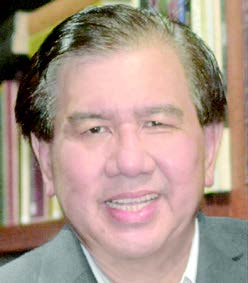The Reed Tablemount
IN LEGAL TERMS

A TABLEMOUNT is a mountain or volcano with a flat top or summit that is found under the sea. It is also known as a guyot (pronounced as "gee-yow"), a name derived from the Swiss American geologist, Arnold Henry Guyot. Flat summits are usually more than 200 meters below sea level, and they are most abundant in the Pacific Ocean. Think of a plateau and submerge it underwater and you've got your tablemount. The Philippines has its own tablemount in the West Philippine Sea or the South China Sea. It is called the Reed or Recto Bank. It covers an area of more than 8,000 square kilometers and is located Southwest of the Philippines near Palawan. In the 1990s, Alcorn Petroleum and Minerals Corp. did extensive survey work in the area.
In 2003, boundaries were drawn in the areas to be explored and exploited for gas and oil. The boundary was carefully delineated to avoid Malaysian waters; it encloses an area of 143,000 square kilometers north and west of Palawan which includes but does not extend beyond the Reed or Recto Bank.
Areas marked for exploration in the sea are divided into irregularly shaped blocks which serve to identify the location of where the exploration and subsequent extraction of oil and gas may be made.
The Department of Energy (DoE) has identified Area 7 in the Recto Bank Basin as the most productive basin in the area. The block covers approximately 468,000 hectares with water depths from 800 to 1,700 meters. The DoE made it known that although no wells have yet been drilled in the block, "that the existence of a working petroleum system in the basin has been proven" and "the estimated resource potential of the block is 165 million barrels of oil and 3,486 billion cubic feet of gas." The block would therefore enable us to replace the almost depleted Malampaya facility which supplies at least 20 percent of our energy needs in Luzon.
In March 2011, the seismic survey ship, MV Veritas Voyager — owned by CGG Veritas, a French company on contract with Forum Energy, a Filipino-controlled company — was conducting a survey over the Reed Bank, which is less than 200 kilometers off Palawan. Two China marine surveillance vessels ordered it to leave the area.
The Arbitral Tribunal, which decided the case of the Philippines vs China, accepted the account of the Philippine Navy, that the Chinese surveillance vessels approached MV Veritas Voyager and informed them that they were operating in the territorial waters of China. The Veritas Voyager replied that it was operating in the territory of the Philippines with all the required permits. The Chinese surveillance vessels then ordered the Veritas Voyager to leave the area.
In its ruling, the Arbitral Tribunal said that regarding the operations of its marine surveillance vessels, China "has breached the Convention with respect to the Philippines' sovereign rights over the non-living resources of its continental shelf in the area of Reed Bank." The body of the decision was later integrated in the dispositive portion of the ruling.
In the early 18th century, Cornelius Van Bynkershoek proposed the adoption of the "cannon-shot rule." According to that rule, the territorial sea of a country is 3 miles from the low-water mark, i.e., the part of the shore where the sea recedes during low tide. Three miles was then the maximum range of a cannon, so the rationale was that a country must be able to physically protect that 3-mile limit of territorial sea which is an extension of a country's land territory wherein it exercises full and unquestioned sovereignty. In other words, according to Cornelius, you cannot claim what you cannot protect. The Philippines may not have the military capability to physically protect our rights over the Reed Bank, but we have international law and the United Nations Convention on the Law of the Sea (Unclos) on our side.
Unclos, wherein the Philippines and China are signatories, clearly delineates the right of the Philippines to exploit the economic resources of the Reed Bank. During various occasions, the Catholic Church has even sent priests to celebrate the Holy Mass in front of the West Philippine Sea.
In his youth, President Ferdinand Marcos Jr. had a picture taken of
himself standing beside the Great Helmsman, Mao Tse Tung. The
Philippines recognized the People's Republic of China (PRC) and adhered
to the "One-China Policy" even before the United States of America
decided to do so. I wonder if during his state visit to the PRC, the
President brought up our long history with the Chinese who came to our
shores not to wage wars of conquest, but to trade, offer their services
as artisans and laborers as they mingled, intermarried and bred a mixed
race of Chinese-Filipinos now called Tsinoys. Their DNA's have become
Filipinized even before those tablemounts were discovered, or their
possession became the subject of claims in the abyss of a hotly
contested sea.